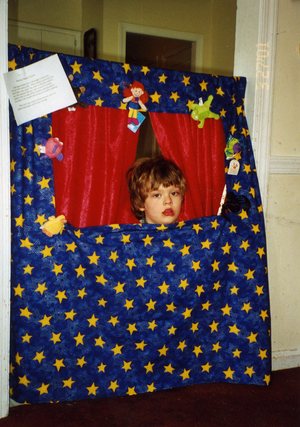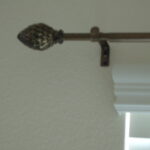Children’s doorway puppet theaters allow children to stage their own dramas from behind a theater curtain. If your children have not done puppetry before, they (and perhaps you) are in for a wonderful surprise. Creativity flourishes with props like this. A kid who never picked up a puppet before won’t put one down once he finds himself “onstage.”
You don’t have to spend a fortune to buy a doorway puppet theater. Doorway puppet theaters are sold in catalogs for upwards of $50. But you can make your own for a fraction of that cost with some cotton fabric, two or three inexpensive spring-loaded curtain rods and a wooden dowel.
Step 1. Measure the width of the doorway in which the theatre will be used.
Step 2. Measure the height from floor to where the top of the curtain will be placed. To determine how high to place the curtain, consider the height of the children and whether they will be sitting or standing when they use the puppet theater. How big of a window opening is up to the maker, but as a general guide, consider placing the top of the window 10-12 inches below the top of the curtain and making the window 12-18 inches long. Widthwise, you will want to leave about a foot from either side of the window to your doorway.
Step 3. Buy the fabric, curtain rods and dowel. If desired three identical curtain rods can be used in lieu of using a dowel.
Use two contrasting pieces of fabric. Check the remnant table in the fabric store first! The first piece of fabric will form the theater itself, so it should be the width of the doorway times the height you have decided to make the puppet theater plus one inch allowance on all sides except the top. The fabric allowance on top should be three inches. The second piece of fabric is for contrasting curtains. The material for these should be the size of the planned window opening plus a half inch leeway at top and bottom and one inch leeway on either side. For especially glamorous curtains, consider buying velveteen remnants.
Choose spring loaded curtain rods that will accommodate your doorway size. Most rods are sold to adjust within a range. As long as your width is in that range, the rod will work. Round rods with small diameters work best. You may either buy three rods or use two rods and a dowel of similar diameter.
Step 4. Cut your fabric if necessary to conform to the measurements you have taken. Make a ½ inch hem on the bottom and both sides of the main piece of fabric. Measure the opening for the curtains and mark it in tailor’s chalk.
Step 5. One-half inch inside the edges of the marked rectangle that is to be the opening, cut a smaller rectangle. Carefully cut a straight line from each corner to the marked corner point of the outer rectangle. This will allow you to fold back the fabric on all sides. Iron all four sides, making sure the fold line is straight. Turn in the edge of each piece of folded fabric and hem. On the bottom edge of the window, make sure and leave the sides of the folded-back piece open so that a dowel or curtain rod may fit inside. From the scraps of fabric, you may, if you choose, reinforce the corners on the reverse side of the puppet theater.
Step 6. From the scraps of cloth cut left over from cutting the inner rectangle create two rectangles 1 1/2 x 2 inches. Fold under 1/4 inch edge on all sides and iron the fold line. Sew the hems on the sides of each rectangle. Then pinning the top and bottom of the rectangles to hold them in place, sew one on each outer edge of the puppet theater ½ inch above the top of the window. Sew the top and bottom only, as close to the edge as possible, so that a curtain rod can slide through.
Step 7. Finish the top of the puppet theater by turning the top ¼ inch of fabric toward the back of the puppet theater and ironing. Make a fold 1 ½ inches down and pin the fabric in place. Sew a seam straight across the bottom of the folded fabric. Leave the sides open. A curtain rod will slip through here to hold the puppet theater in place.
Step 8. Make the curtains. Measure the size of the window opening. Divide the width in half. The width of each curtain should be half the width of the opening plus one inch (1/2 inch hem on either side). The height of each curtain should be the height of the opening plus 2 ½ inches.
Hem each curtain ½ inch on the bottom and side of each curtain. For the top of each curtain, fold back the top ¼ inch of fabric, reverse sides touching. Iron, and then fold the top back again 1 ½ inches. Sew across the bottom of the fold and leave the sides open. Place the curtains on one of the rods, adjust the rod to a tension smaller than the doorway and slip one end of the rod through the pocket. Push the curtains and the rod toward that end until you can slide the other end of the rod into its pocket. If the curtains sag (depends on width of window and weight of material), you can make a small fabric loop from a scrap and sew it to the back of the theater in the middle of where the curtains open. Slipping the rod through this extra support will eliminate sagging. Once the curtains are in place, the rod can be adjusted to the doorway width.
Step 9. Insert the dowel or extra rod through the open seam at the window bottom. The function of this dowel or rod is to prevent sagging. Place the final rod through the top opening of the theater, hang puppet theater in doorway, and adjust the tension to hold it in place. Adjust the tension of the other rod(s) as necessary.
Step 10. Pull out the puppets and let the dramas begin. Finger puppets, hand puppets or marionettes? They all work with this puppet theater and they all draw out the child’s creative genius.





